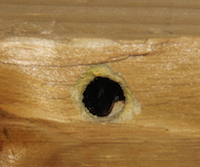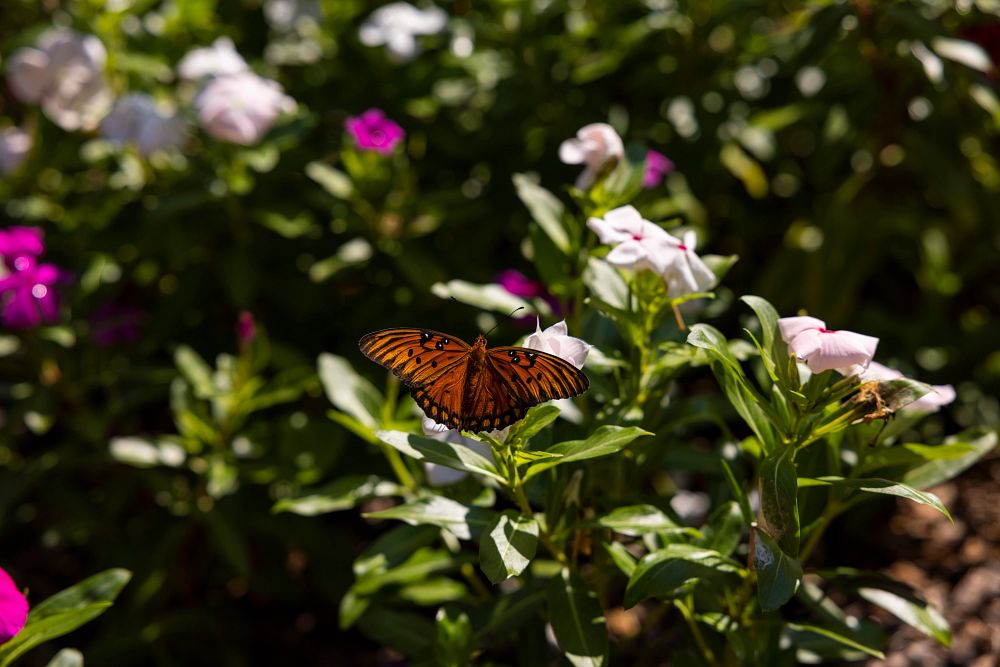Deborah Harris sits on her porch swing and watches carpenter bees fall into a Mason jar trap.
“I’ve trapped five so far, and I’ve ordered 10 more of these traps for my friends,” said Harris, a resident of rural Butts County.
Tired of watching the bees slowly gnaw through the wood on her porch, Harris bought one of the traps as an alternative to spraying pesticides. Even if its not a longterm solution to her carpenter bee problem, it is satisfying to watch the saw dust spilling bees plunk down into the after watching them attack her porch.
Whether its with traps, treated wood or pesticides, most Georgia homeowners face an annual battle against carpenter bees. There tale-tell piles of sawdust can mean destruction or even most well-constructed porch, but entomologist warn that they also serve important roles as pollinators in Georgia's landscape.
Like bumblebees, but different
Carpenter bees look like bumblebees minus the yellow markings. They are black with areas of yellow hair and are typically about an inch long. Males have a white spot on the front of their face.
Female carpenter bees can inflict a painful sting, but they seldom do. Male carpenter bees cannot sting but love to hover over humans, trying to frighten us away.
Adult bees only live a few weeks but irritate homeowners in that short time period by drilling through wood to lay their eggs. They prefer bare, unpainted or weathered softwoods like redwood, cedar, cypress and pine. Painted or pressure-treated wood usually goes untouched.
“They are found usually in porch ceilings, windowsills, doorframes, headers, rafters and siding,” said Steve Morgan, University of Georgia Extension agent in Harris and Talbot counties.
Drilling holes, making sawdust
Carpenter bee holes and tunnels are perfectly round and about the diameter of a finger. Coarse sawdust beneath an entry hole and burrowing sounds are often the first signs of the bees.
“They drill approximately an inch into the wood and tunnel along with the grain,” Morgan said. “Since they often reuse the same spots, holes and tunnels may reach up to several feet in length. They can do severe damage over the long term. Each generation carves nest partitions by chewing the insides of the tunnel and making a paste to create their nest.”
Carpenter bees overwinter as adults in abandoned nest tunnels. They emerge in the spring, usually in April or May. After mating, the female drills holes in wood and lays her eggs within a series of small cells. She adds a ball of pollen on which the larvae will feed until they emerge as adults in late summer.
Spray at night in the spring
If you want to spray pesticides to control carpenter bees, UGA Extension experts say spring is the best time to do so since the bees are active and the holes can easily be found. Bill Tyson, UGA Extension agent in Effingham County, also suggests painting wood as a preventative control method.
“Painting the wood with several coats of an oil-based or polyurethane paint will discourage the bees, but it won’t make the wood bee-proof,” he said. Tyson recommends applying permethrin and cyfluthrin sprays to wooden surfaces.
Spraying adults with aerosol insecticides will kill them, but spraying wood surfaces won’t. The insecticide must be injected into each burrow to be effective. For this, Tyson suggests using carbaryl or deltramethrin dusts labeled for carpenter bee control.
Morgan recommends spraying for carpenter bees at night because the adults may not be near the nest during the day. Leave the hole open for a few days after treatment to allow the bees to come in contact with and distribute the insecticide throughout the nest galleries. Then plug the holes with a wooden dowel, caulk or wood putty.
If carpenter bees continue to be an issue, apply additional residual insecticide treatments at weekly or twice weekly intervals.
Don't ignore them
Large and noisy, carpenter bee larva often attract woodpeckers who find them tasty. Unfortunately for homeowners, woodpeckers can cause further damage when they hunt for carpenter bee larva. If you see woodpeckers on the eave of your home, they are more than likely in search of the carpenter bee larva.
In Gwinnett County, UGA Extension agent Robert Brannen experienced woodpecker damage first hand. “Last summer, two woodpeckers came along and apparently spent the day digging the larvae out. They tore holes in the wood, so that you could throw a softball through,” he said. “My deck was seriously damaged. I don’t suggest ignoring (carpenter bees).”
In spite of their destructive powers, carpenter bees have good pollinating qualities.
“After the female carpenter bee makes its 10-inch tunnel, she visits all the local flowers and gathers pollen for her eggs. As she visits from flower to flower she transfers the pollen making larger and tastier fruit,” said Troup County Extension agent Brian Maddy.
The importance of non-honeybee pollinators is growing as the number of honeybees declines. These insects are also called pollen bees or solitary bees.
Maddy prefers to keep carpenter bees alive for this reason. “If you have a problem with bees around the porch and there are no flowers to pollinate, light a citronella candle,” he said. “It may work and keep the bees busy doing what they do best – pollinating.”






.png)


